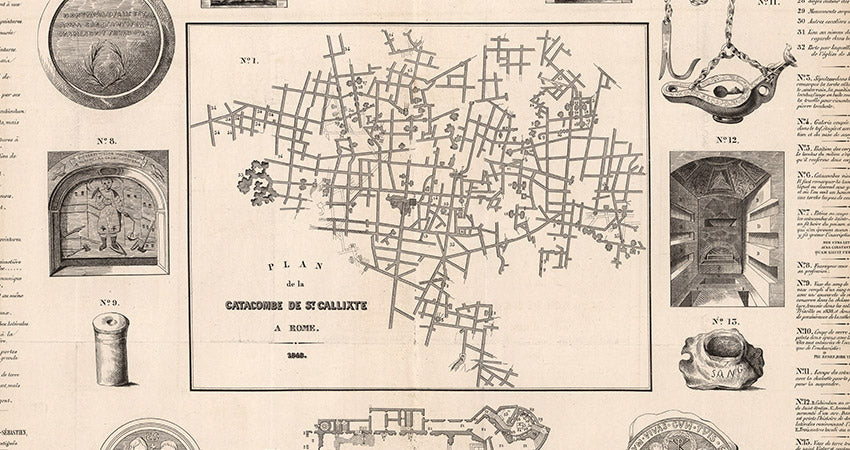
Catacomb of San Callisto in Rome. A window into history
Alessandro TrizioShare
An 1848 lithograph by Vandermaelen offers a detailed depiction of the Catacombs of St. Callixtus in Rome, providing a valuable window into the history and culture of early Christianity. This map, in addition to revealing the complex network of tunnels and burial chambers used by the early Christians, is a testimony to the life and funerary practices of that era.

Vandermaelen's lithograph, characterized by meticulous precision, features a central map illustrating the network of catacombs. Numbered legends on the sides explain the features and locations within the catacombs, offering a detailed guide through this intricate underground labyrinth. In particular, numbers 3-6, 8-10 and 12-13 show engravings depicting internal decorations such as frescoes, tombs, tools and objects found during explorations. Number 11 is dedicated to the representation of an ancient lantern used to illuminate the dark corridors of the catacombs, while number 14 shows a seal with religious figures, evoking the profound Christian traditions of the time.
The Catacombs of San Callisto, excavated in the 2nd century AD, are among the largest and most important in Rome. They take their name from Pope Callisto I, who managed them before becoming pontiff. These catacombs not only served as a burial place, but were also a refuge during the persecutions of Christians.
They house the tombs of dozens of Christian martyrs and sixteen pontiffs, making them a site of inestimable historical and religious value. The pictorial decorations and the Popes' crypt are among the most famous features of these catacombs, offering a fascinating glimpse into the history of early Christianity.
Vandermaelen's lithograph is not only a work of art, but a historical and archaeological source of great importance. It precisely maps the structure of the catacombs, providing a rich context for understanding the site. Detailed notes and illustrations allow you to visualize the life and funerary practices of the early Christians.
Furthermore, this map is a significant example of how 19th century cartographers and archaeologists documented and studied ancient sites. Vandermaelen's work contributes to the preservation and knowledge of Rome's historical and cultural heritage, offering an essential tool for scholars and history enthusiasts.
Vandermaelen's 1848 lithograph of the Catacombs of St. Callixtus is a precious testimony to the past, which continues to illuminate our understanding of the practices and lives of the early Christians. Thanks to works like this, the historical and cultural heritage of Rome is carefully preserved and studied, keeping the memory of distant eras alive.
